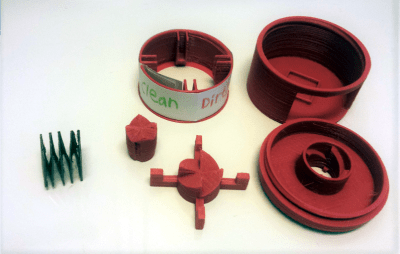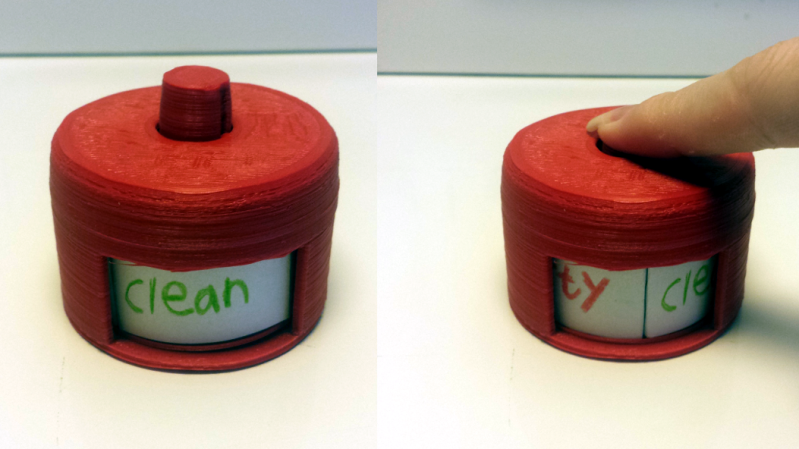[u407]’s 3D printed Signspinner was created as a clean/dirty indicator for a dishwasher, and at its heart is a mechanism that works a lot like that of a retractable ballpoint pen. Every click of the plunger spins the circular label inside by one-quarter of a rotation. In [u407]’s case it only needs to alternate between showing “clean” and “dirty”, but there are in fact four total label positions.
 The entire mechanism including the spring is 3D printed, but the spring is PETG and the rest is PLA. [u407] doubts PLA would work for the spring because of how much it gets compressed, but suggests that ABS might work as an alternative.
The entire mechanism including the spring is 3D printed, but the spring is PETG and the rest is PLA. [u407] doubts PLA would work for the spring because of how much it gets compressed, but suggests that ABS might work as an alternative.
If you’re having trouble visualizing how this mechanism works, we covered [Bill Hammack] explaining exactly how retractable ballpoint pens work which should make it perfectly clear. It’s fundamentally the same principle.
[via Reddit]
















funny little device.
But if you need it, then your dishes just aren’t dirty enough… or the washer does a lousy job.
Or you have housemates who don’t look at the dishes inside before shoving more dirty dishes in.
As a kid I had a mechanical traffic light that worked like this. I dreamed of an electric one back then but now I realise how the mechanical one was cooler.
Never understood these things. Why on earth are they necessary? If it’s clean, empty the damn thing! And if it’s not clean, it should be obvious, as Jan says
It’s for households where multiple people interact with the dishwasher and the person who starts the dishwasher might not be there when the cycle finishes. You make sure everybody knows that 1) when you start the machine, switch it to “clean”, 2) if it says “clean” and the machine isn’t running, it needs to be emptied, and 3) when you empty it, switch it to “dirty”
Some people don’t follow all your rules. They’re used to other people accommodating them, not the other way around. Sometimes, you have to live with such people. Life isn’t ideal.
Some people keep the clean dishes in the DW and the counter and sinks are full of dirty dishes. Only when emptied out will some of the garbage caked stuff get “cleaned”.
On subject. Make the count which is 4, 7 for days of the week. Any other cycle like 5 for market day in some places in Africa etc. or a set of states of whatever are a few examples.
To those asking why this is helpful: when you’re finished eating, you take your plate to the sink, scrape off the food, and put it in the dishwasher. It’s so automatic and you do it so fast that you might not notice that the dishes are clean. If you walk away, then no one else knows there’s a dirty plate and they’ll think everything is clean. If you catch yourself, you can pull the dirty plate out, but it’s harder with utensils: you usually won’t know which utensil is the dirty one.
My wife and I use a magnet on the DW to indicate when dishes are clean.
With my wife we leave the dishwasher on until it’s emptied. The green light means “clean”.
But not all dishwashers are as luxurious with them blinken lights. For ex. the build in kind ;)
It’s really very simple as long as your dishwasher has a dispenser with a cover. Just refill the dispenser and close the cover immediately after you unload the clean dishes.
Later on – A dishwasher containing clean dishes will have a dispenser with an open cover. A dishwasher containing dirty dishes will have a dispenser with a closed cover.
First, this hack is about a cool mechanism. There are a ton of slide-a-sign-back-and-forth dishwasher state labels, and probably half a ton on Thingiverse. They are purely utilitarian. This one is awesomer.
But all of the “open the dishwasher up and check if it’s dirty” suggestions ignore the central problem this solves — I don’t wanna open up the dishwasher when I have my hands full of dishes. I just want to know the washer’s state so that I can make the relevant decision about where to land them. (Full disclosure: we don’t have such a system, we’d forget to set it every time, but I totally understand the need.)
Anyway, the dishwasher label, the dog-poo bag dispenser, the bottle opener, the whistle, and plastic bag handles are a few of the many small items that people design and design again on Thingiverse. Oh, and maybe headphone hooks. A clever product designer would trawl Thingiverse to find what people are missing in their lives, and make millions. Millions, I tell you!
Don’t forget sd card holders (who needs that many sd cards?) I think it’s more of “can I design this myself without having full engineering degree”.